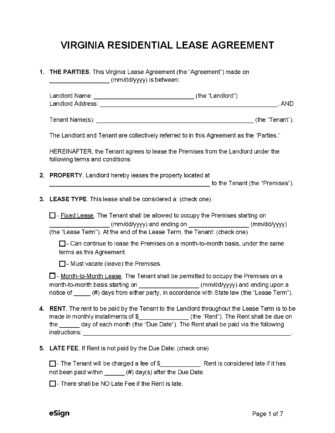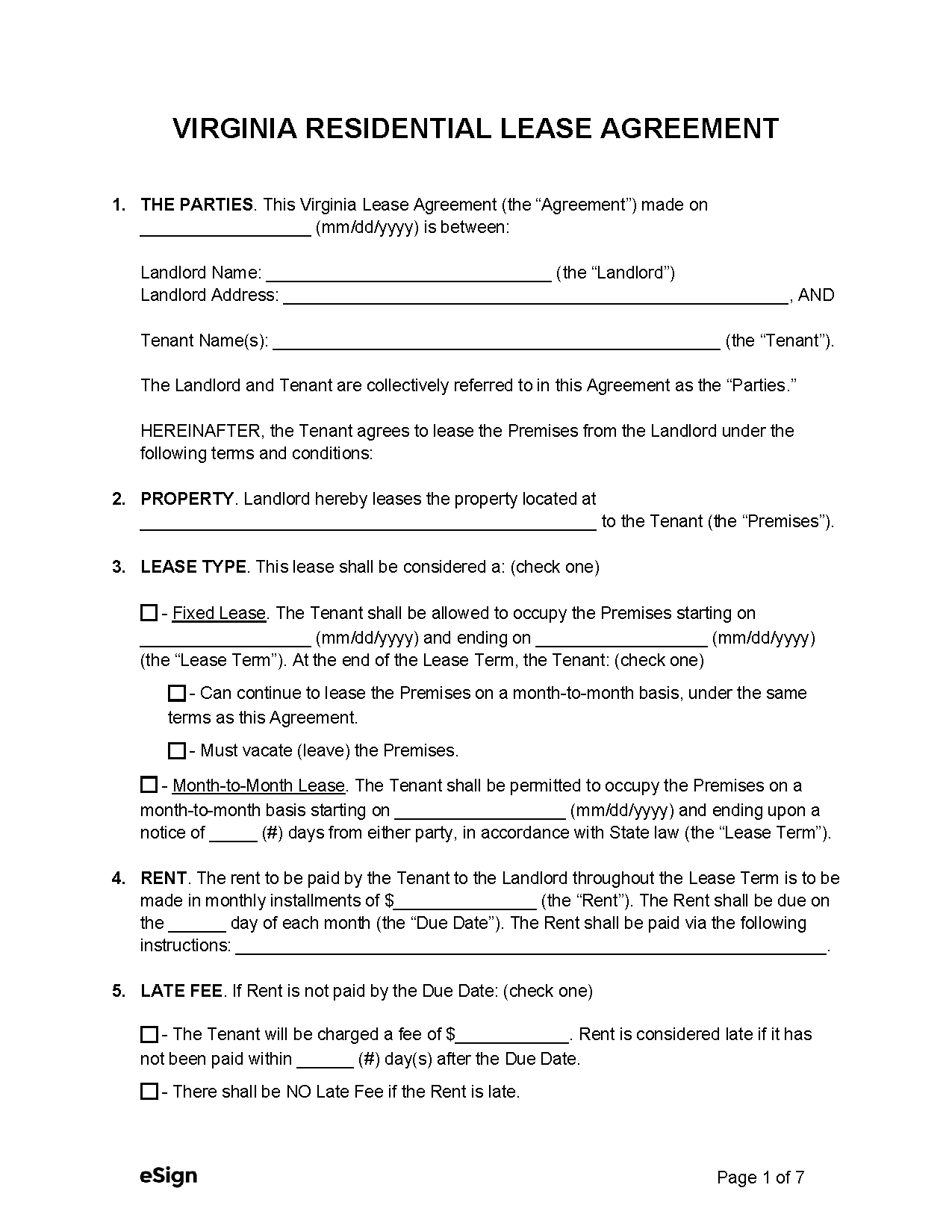
A Virginia lease agreement is the contract used to rent commercial or residential property. Each lease outlines the tenant’s financial responsibilities during the tenancy and establishes the rent amount, the payment due date, utility fees, security deposits, and the liabilities associated with failing to comply with the lease document.
A Virginia lease agreement is the contract used to rent commercial or residential property. Each lease outlines the tenant’s financial responsibilities during the tenancy and establishes the rent amount, the payment due date, utility fees, security deposits, and the liabilities associated with failing to comply with the lease document.
PDF Download
A Virginia lease agreement is the contract used to rent commercial or residential property. Each lease outlines the tenant’s financial responsibilities during the tenancy and establishes the rent amount, the payment due date, utility fees, security deposits, and the liabilities associated with failing to comply with the lease document.
4.8 | 4 Ratings Downloads: 2,170
Rental Application – Completed by lease applicants to disclose their personal information to the landlord as well as authorize a background check.
Maximum Amount ($) – Landlords may not demand more than two months’ rent for a security deposit. [12]
Collecting Interest – State law does not make requirements for the collection and distribution of interest on security deposits.
Returning to Tenant – Security deposits must be returned within 45 days.
Itemized List Required? – Yes, after a move-out inspection takes place, the landlord must provide an itemized list of damages to the tenant. [13]
Separate Bank Account? – No, the use of a separate bank account for security deposits is not mentioned in state statutes.
General Access – 72 hours’ notice must be given for routine maintenance that was not requested by the tenant. If the tenant requests repairs or maintenance, the landlord may enter without giving notice to the tenant. [14]
Immediate Access – Landlords may enter without consent in the case of an emergency. [15]
Grace Period – Late fees can be applied if the rent is not paid within the first five days of the due date. [16]
Maximum Late Fee ($) – The maximum late fee is 10% of the periodic rent payment or 10% of the remaining amount owed to the landlord, whichever is less. [17]
Bad Check (NSF) Fee – The landlord may be able to charge a tenant $50 plus interest and any fees charged by their bank for a bounced check. [18]
Withholding Rent – If a tenant notifies a landlord of damages or an infestation on the property that is a health or safety risk, the landlord has 14 days to fix the issue. If they fail to remedy the problem, the tenant can hire a third party and deduct the costs from their rent up to $1,500 or one month’s rent, whichever is greater. [19]
Non-Payment of Rent – After the five-day grace period, landlords can serve a 5-day notice to pay or quit if a tenant still hasn’t paid rent. [20]
Non-Compliance – When a tenant fails to comply with the lease agreement, the landlord can deliver a notice to quit for non-compliance stating that the tenant has 21 days to fix the issue or the lease will terminate 30 days from the date of delivery. [21]
Tenant Maintenance – The tenant is required to maintain the cleanliness and safety of the premises, use all services and appliances with care, and avoid damaging, removing, or changing any part of the property without the landlord’s consent. [23]
Lockouts – The landlord cannot intentionally bar the tenant from entering the property. [24]
Leaving Before the End Date – A rental property is considered abandoned by the tenant if they are absent for over seven days and the landlord notifies them that they will terminate the tenancy if they do not reply to the notice within seven days. For this law to apply, landlords have to include in the lease a section stating that the tenant has to give notice every time they plan on being absent for more than seven days. [25]
Month-to-Month – A landlord or tenant can terminate a monthly lease agreement without cause by delivering a 30-day notice to the other party. [26]
Unclaimed Property – Personal property left on the premises by the tenant can be disposed of by the landlord if they provide one of the following notices [27] :